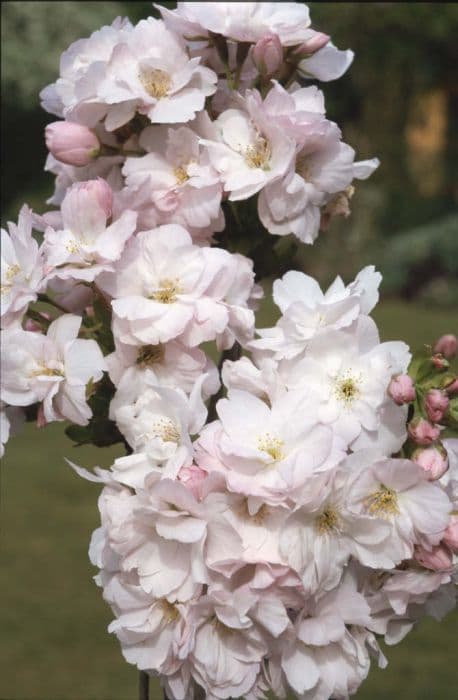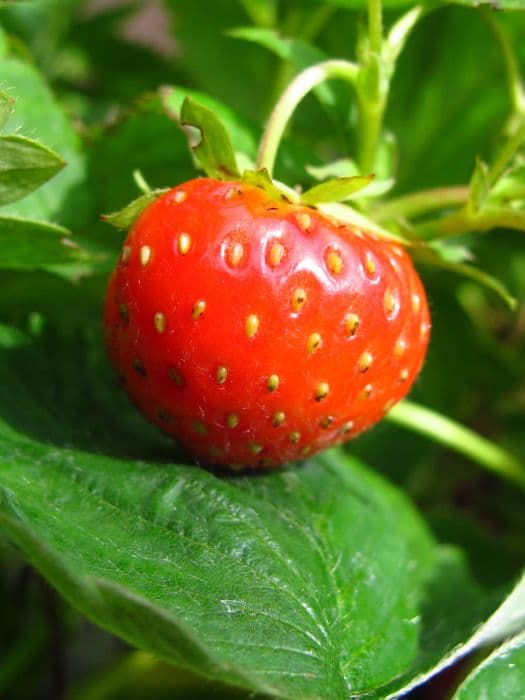Rosa Mundi Rosa gallica 'Versicolor' (G)

ABOUT
Rosa gallica 'Versicolor', commonly known as the French Rose or the Rosa Mundi, is celebrated for its unique and vibrant blooms. The flowers of this rose are distinct because of their striking multi-colored petals which present a captivating blend of deep pink and creamy white, often streaked or splashed with both colors to create an effect reminiscent of a painter's brush strokes. Each of the full, rounded blooms typically bears a densely packed cluster of petals, creating a lush, old-world rosette shape that evokes a sense of classic garden elegance. The petals have a velvety texture and may sometimes show small hints of a lighter or darker shade, lending each flower an individual character. These roses generally have a strong, sweet fragrance that is as delightful as their appearance, making them a favorite among gardeners and flower enthusiasts for their scent and beauty. The leaves of the French Rose are a rich green, providing a lovely contrast to its dramatic flowers, and they carry a matte finish that underscores the brilliance of the blooms. As a bush, the French Rose tends to be well-rounded, presenting a dense and shrubby appearance with a rustic charm. This contributes to its popularity for use in cottage gardens and as an ornamental plant in various landscapes, where its stunning coloration and pleasant fragrance can be appreciated up close.
About this plant
 Names
NamesFamily
Rosaceae.
Synonyms
French Rose, Rosa Mundi, Gallica Versicolor Rose.
Common names
Rosa gallica 'Mundi', Rosa gallica 'Variegata', Rosa mundi.
 Toxicity
ToxicityTo humans
The Rosa gallica 'Versicolor', commonly known as the French Rose or the Apothecary's Rose, is generally not considered toxic to humans. There is low risk of serious toxicity when parts of these plants are ingested. In some cases, consuming plants in the Rosa genus could potentially cause mild gastrointestinal upset, such as nausea or diarrhea, due to the various compounds found in the plant's leaves and stems. However, the rose hips, or the fruit of the rose plant, are edible and are even used in culinary applications for their high vitamin C content and for making herbal teas and jams.
To pets
The Rosa gallica 'Versicolor', commonly known as the French Rose or the Apothecary's Rose, is not considered toxic to pets such as dogs and cats. It is generally safe if pets come into contact with this rose or ingest parts of it. However, thorns can cause physical injury and there is a potential for mild gastrointestinal upset, including symptoms like vomiting or diarrhea, if a pet ingests parts of the rose plant. It is always advisable to monitor pets and prevent them from eating large amounts of any non-food plant, as it could cause stomach discomfort or an intestinal blockage.
 Characteristics
CharacteristicsLife cycle
Perennials
Foliage type
Deciduous
Color of leaves
Green
Flower color
Mixed
Height
3-4 feet (0.91-1.22 meters)
Spread
2-3 feet (0.61-0.91 meters)
Plant type
Shrub
Hardiness zones
5
Native area
Europe
Benefits
 General Benefits
General Benefits- Aesthetic Appeal: Rosa gallica 'Versicolor', also known as the Apothecary's Rose, is prized for its unique striped or mottled flowers that add visual interest to gardens and landscapes.
- Historical Significance: The Apothecary's Rose has a rich history, having been used and admired since the Middle Ages, and can provide a historical element to a garden.
- Wildlife Habitat: The plant can attract and support beneficial pollinators such as bees, butterflies, and other insects.
- Scented Garden: The blooms of the Apothecary's Rose are often fragrant, adding a pleasant olfactory experience to the garden.
- Cut Flowers: The flowers are suitable for cutting and can be used to create attractive indoor bouquets and floral arrangements.
- Cultural Symbol: The rose is a cultural icon, symbolizing love and beauty, and can bring these associations into a garden or landscape setting.
- Hardiness: Rosa gallica 'Versicolor' is known for being hardy and disease-resistant, making it a relatively low-maintenance choice for gardeners.
 Medical Properties
Medical Properties- Anti-inflammatory: The petals of the Apothecary rose contain compounds that may help reduce inflammation.
- Antioxidant: It is known to have antioxidant properties, likely due to the presence of flavonoids and vitamins.
- Astringent: The petals can be used for their astringent properties to tone the skin and tighten pores.
- Antibacterial: Some studies suggest the presence of antibacterial properties in the essential oils extracted from the plant.
- Antiviral: The Apothecary rose is believed to have antiviral capabilities, although substantial scientific data is limited.
- Skin conditions: Traditionally used to soothe and help treat minor skin conditions like abrasions or rashes.
 Air-purifying Qualities
Air-purifying QualitiesThis plant is not specifically known for air purifying qualities.
 Other Uses
Other Uses- Rosa Mundi petals can be used to create natural dyes for fabrics, giving them a beautiful and subtle range of colors, depending on the mordant used.
- The petals of Rosa Mundi can be used in potpourri mixtures, blending their unique coloration with a fragrant and long-lasting scent.
- Can be incorporated into bath bombs and salts for a luxurious, floral-scented bathing experience.
- The petals can be added to envelopes and writing papers for a decorative, romantic touch, or used as bookmarks.
- Rosa Mundi petals can be infused in oils or vinegars to impart their color and a hint of their fragrance to culinary creations.
- Pressed Rosa Mundi petals can be used in scrapbooking and papermaking for their visual appeal.
- Petals can be used to decorate cakes and desserts, offering an edible enhancement that's both beautiful and unique.
- Can be used in crafting biodegradable confetti, which is perfect for eco-friendly celebrations.
- Rosa Mundi can be used in photographic projects, where the distinctive petals can serve as a natural colorant for photographic prints using anthotype process.
- Can serve as a natural ingredient in creating plant-based inks for art and calligraphy purposes.
Interesting Facts
 Feng Shui
Feng ShuiThe Rosa Mundi, the most common name for Rosa gallica 'Versicolor', can be used in Feng Shui to create a loving and positive energy in the home. It is often placed in the Southwest area of a garden or room, which is associated with love and marriage, to enhance romantic relationships and harmony. Its vibrant colors can also be used to add an element of Fire to a space, representing energy, passion, and enthusiasm.
 Zodiac Sign Compitability
Zodiac Sign CompitabilityThe Rosa Mundi is not used in astrology practice.
 Plant Symbolism
Plant Symbolism- Love: As a member of the rose family, the Rosa gallica 'Versicolor', commonly known as the French Rose, often symbolizes love and romantic emotions.
- Mystery and Intrigue: The unique striped and variegated pattern of the French Rose's petals can represent mystery or something unique and striking, symbolizing an object of intrigue.
- Beauty: Roses are widely recognized as symbols of beauty owing to their elegant form and captivating appearance, and the French Rose is no exception.
- Pride: With its bold colors and commanding presence, the French Rose is sometimes used to represent pride or confidence.
- Healing: Historically, roses have been used for their medicinal properties, which might be why the French Rose can symbolize healing or comfort.
 Water
WaterThe Rosa Mundi, the most common name for Rosa gallica 'Versicolor', requires consistent moisture, especially during its growing season in spring and summer. Water it when the top inch of soil feels dry, which typically means once a week, but this can vary with climate conditions. It's best to water this plant in the morning to allow foliage to dry out during the day, thereby reducing the risk of disease. Use a soaker hose or drip irrigation to deliver water directly to the base and avoid wetting the foliage. Each plant will likely need about 1 to 1.5 gallons of water each time you water, making sure the soil is moist but not waterlogged.
 Light
LightThe Rosa Mundi prefers full sun conditions, which means it should receive at least 6 to 8 hours of direct sunlight each day. The best spot for planting is in an area that gets unfiltered sunlight throughout most of the day. Avoid locations where buildings, trees, or other structures might cast significant shade on the plant for extended periods of time.
 Temperature
TemperatureThe Rosa Mundi can endure a range of temperature conditions and is hardy in most temperate climates. It can survive minimum temperatures down to about 0°F, while maximum temperatures should ideally not exceed 90°F for prolonged periods. The ideal growing temperatures for this rose are between 65°F and 75°F.
 Pruning
PruningPruning the Rosa Mundi is essential to encourage vigorous growth and improve air circulation, which can prevent disease. The best time to prune is in late winter or early spring before new growth begins. Remove any dead or diseased wood, thin out crowded areas, and shape the plant to maintain an open structure. This should be done annually, and sometimes light pruning may be needed during the growing season to remove spent flowers or unruly branches.
 Cleaning
CleaningAs needed
 Soil
SoilThe Rosa Mundi, commonly known as the Apothecary's Rose, thrives in well-drained, loamy soil enriched with organic matter such as compost or well-rotted manure. The ideal soil pH for this plant is between 6.0 and 7.0. A good soil mix for the Rosa Mundi would be one-third topsoil, one-third well-aged compost, and one-third sharp sand to ensure adequate drainage.
 Repotting
RepottingApothecary's Roses, like Rosa Mundi, are typically grown outdoors and do not require repotting as they are not kept in containers. Instead, they are usually planted once in a location where they can grow indefinitely without the need for repotting.
 Humidity & Misting
Humidity & MistingThe Apothecary's Rose, like most roses, prefers outdoor conditions where the humidity is naturally regulated. It doesn't require high humidity and will tolerate the average outdoor levels well.
 Suitable locations
Suitable locationsIndoor
Place in sunny spot, water deeply when soil is dry.
Outdoor
Plant in sunny area with well-drained soil.
Hardiness zone
4-9 USDA
 Life cycle
Life cycleRosa gallica 'Versicolor', commonly known as the French Rose or the Rosa Mundi, begins its life cycle as a seed, which germinates in the soil when conditions are right—typically in late winter or early spring. After germination, the seedling emerges and grows into a young plant, developing a root system and foliage through the vegetative stage. As it matures, the French Rose enters the flowering stage, typically in late spring to summer, where it produces its characteristically striped or mottled pink and white blooms that are capable of self-pollination or cross-pollination by insects. Following pollination, the flowers develop into fruit, known as hips, which contain seeds for the next generation. The plant then goes into a period of dormancy during the colder months, where growth slows down significantly. At the onset of the next growing season, the cycle begins again as the French Rose resumes growth with new shoots and leaves, eventually leading back to its flowering stage.
 Propogation
PropogationPropogation time
Spring to Summer
Propogation: The Rosa gallica 'Versicolor', also known as the French Rose or the Rosa Mundi, is traditionally propagated through the method of hardwood cuttings. This popular propagation technique involves taking a cutting from a mature plant during the dormant season, which typically ranges from late fall to winter. A suitable stem for a hardwood cutting is one that has matured over the summer and has turned woody. The cutting, about 6 to 8 inches (15 to 20 centimeters) in length, should include several nodes where leaves attach as these areas contain the latent buds that will grow into new shoots. To increase success rates, the bottom end of the cutting is often dipped in rooting hormone before it is planted in a well-drained soil mix, and then it's kept moist until the cutting has rooted and can be transplanted into the garden. Gardeners may also use bottom heat to encourage root development, though it's not always necessary.








